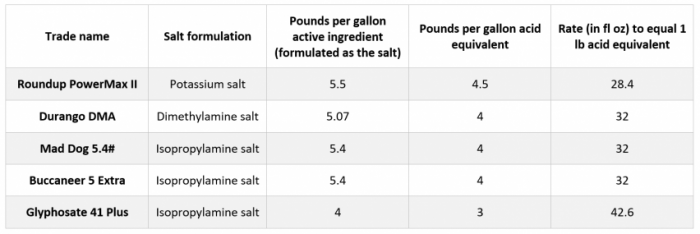Determining the appropriate glyphosate rate is probably more important this spring than in previous years. Between high herbicide prices, reduced supply, and possibly using a different glyphosate product, it is worth checking to make sure you’re applying the optimum rate for efficient control.
Many farmers may have used a 32 fluid ounce rate of glyphosate in the past. Since glyphosate comes in formulations containing a range of concentrations, the amount of glyphosate in 32 fluid ounces can vary significantly among products. Depending on what glyphosate product you’ve purchased for this year, your application rate may need to be different than prior years to deliver the same amount of herbicide.
When making comparisons across glyphosate formulations, we always want to compare them based on the amount of acid equivalent rather than active ingredient. An example of the ingredient statement on a glyphosate product’s label shows where you can find this information (Figure 1).
 Figure 1. Typical ingredient statement found on pesticide labels.
Figure 1. Typical ingredient statement found on pesticide labels. Table 1 compares the amount of glyphosate active ingredient and acid equivalent found in several popular glyphosate products. The far right column shows the equivalent rate required by the products to provide one pound of glyphosate acid equivalent; I calculated this by dividing 128 (number of fluid ounces in a gallon) by the amount of acid equivalent per gallon for the product. If a farmer has used a 4.5 pound per gallon acid equivalent product and switches to a 4 pound per gallon acid equivalent product, their application rate to deliver the same amount of herbicide will need to be increased this year.
 Table 1. Comparison of composition of several glyphosate products.
Table 1. Comparison of composition of several glyphosate products.
Even if you are using the same glyphosate product as in prior years, it is worth evaluating whether your rate is appropriate for the weeds found in your fields. For most farmers, glyphosate rates were increased due to decreasing control of waterhemp. Unfortunately, waterhemp has outpaced us and glyphosate is no longer effective at any rate against this weed in many Iowa fields. I encourage farmers to carefully check the label for their chosen glyphosate product and determine the suggested rate to manage target weed species. This may mean a slight reduction in rate for postemergence glyphosate applications or perhaps an increase if you’re managing particularly stubborn weeds like some perennials.
This article did not address other considerations for glyphosate applications that are nearly as important as choosing the right rate, including weed size, weather conditions, nozzle selection, spray adjuvants and tank mix partners. Careful consideration of the glyphosate formulation and label recommendations will help provide optimum weed control while protecting the pocketbook this spring.







Post a comment
Report Abusive Comment